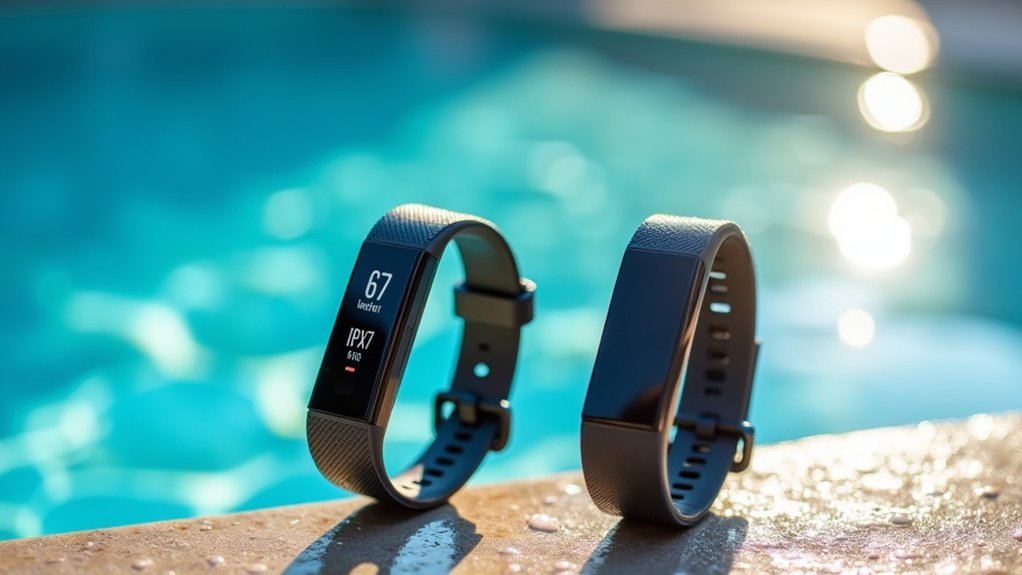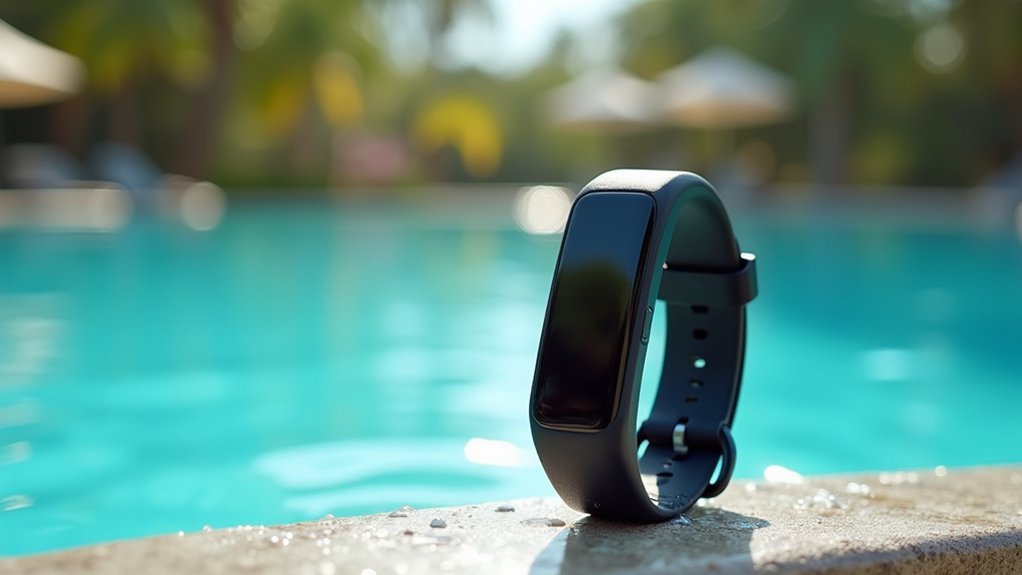You’ll need a minimum IPX8 rating to guarantee your fitness tracker can handle regular pool workouts and swimming sessions safely. While IPX7 protects against submersion up to 1 meter for 30 minutes, IPX8 goes beyond that threshold, typically rated for 1-2 meters depth for extended periods. This higher certification provides the assurance needed for repeated aquatic use and sustained swimming activities. However, understanding the complete picture of pool-safe features involves more than just waterproof ratings.
Understanding IPX8 Rating Requirements for Swimming Activities

When you’re shopping for a fitness tracker that can handle swimming workouts, the IPX8 rating represents the gold standard for waterproof protection. This certification indicates your device can withstand continuous underwater immersion beyond 1 meter depth, making it ideal for swimming and diving activities.
Unlike lower ratings, IPX8 doesn’t specify universal parameters—manufacturers define exact submersion depth and duration limits. You’ll typically find devices rated for 1-2 meters depth for 30 minutes or more. The certification process guarantees your tracker remains fully functional after extended water exposure under these specified conditions. Independent testing organizations conduct rigorous evaluations to determine these IP ratings, ensuring accurate waterproof classifications for consumer safety.
For swimming activities, you should follow manufacturer guidelines describing maximum immersion depth and duration. This rating assures your fitness tracker can handle chlorinated pool water and sustained underwater contact without operational failure.
Depth Resistance Specifications Beyond Basic IPX Classifications
While IPX8 ratings provide excellent baseline protection for pool activities, manufacturers often implement additional depth resistance specifications that go beyond these basic classifications.
You’ll find devices with 5 ATM ratings can withstand submersion up to 50 meters, making them suitable for pool swimming and snorkeling. Many manufacturers follow ISO standards like 22810:2010 to guarantee compliance with specific water resistance criteria.
You should note that IPX8 focuses solely on water resistance, unlike IP68 which provides both dust and water protection.
Each manufacturer specifies different depths and durations for their IPX8-rated products, so you’ll need to check these specifications carefully.
Always verify manufacturer specifications for IPX8 depth and submersion duration limits before exposing your device to water.
While these devices handle pool conditions well, they’re not recommended for high-velocity water activities or scuba diving unless specifically designed for such use. Water resistance levels vary by model, with some offering only splashproof protection while others can withstand complete immersion.
Essential Swimming Features in Pool-Safe Fitness Trackers
Beyond water resistance ratings, your pool-safe fitness tracker needs specific swimming features to deliver meaningful workout data.
Essential capabilities guarantee you’ll get accurate metrics whether you’re training for competition or maintaining fitness.
Key swimming features to look for:
- Automatic lap counting and stroke detection – Tracks swimming volume and technique without manual input
- SWOLF score calculation – Measures efficiency by combining stroke count and swim time
- Multiple stroke recognition – Identifies freestyle, backstroke, breaststroke, and butterfly automatically
- Split time and interval tracking – Supports structured workouts and recovery management
- Swimming-specific heart rate algorithms – Filters water movement noise for more accurate readings
Consider app syncing compatibility with specialized swimming applications like MySwimPro or Swim.com for enhanced workout analysis and training programs.
These features transform basic waterproof devices into thorough swim training tools that optimize your pool workouts.
Chemical Resistance and Durability in Chlorinated Pool Environments
Though IPX ratings indicate water resistance, they don’t address the chemical challenges your fitness tracker faces in chlorinated pools. Chlorine’s aggressive nature can degrade rubber, silicone, and plastic components over time, causing them to harden or crack. This compromises sealing integrity, allowing chemical ingress that surpasses typical water resistance testing.
IPX ratings don’t protect against chlorine’s chemical assault on fitness tracker seals and materials over time.
Your tracker’s materials greatly impact durability. Stainless steel or titanium casings outperform aluminum, while anti-corrosion coatings protect charging pins and sensors.
Manufacturers like Apple and Garmin design specific models for pool use, though they lack standardized chemical resistance certifications. Most waterproof fitness trackers are water-resistant up to 50m, providing adequate protection for standard pool depths and swimming activities.
You’ll extend your tracker’s lifespan by rinsing it with fresh water after each pool session and checking seals regularly for wear. Look for “pool-safe” or “chlorine-resistant” claims beyond standard IPX ratings.
Comparing IPX7 Vs IPX8 Performance for Water Sports

When you’re choosing a fitness tracker for water sports, the difference between IPX7 and IPX8 ratings becomes essential for your device’s survival and performance.
IPX7 devices handle submersion up to 1 meter for 30 minutes, making them suitable for accidental splashes but insufficient for sustained swimming. IPX8 devices excel in continuous underwater use beyond 1 meter depth.
Here’s what sets them apart for water sports:
- Submersion duration: IPX7 limited to 30 minutes vs. IPX8 for prolonged periods
- Depth resistance: IPX7 maxes at 1 meter vs. IPX8 beyond manufacturer specifications
- Swimming suitability: IPX7 not recommended vs. IPX8 designed for pool workouts
- Device reliability: IPX8 offers greater assurance for repeated aquatic use
- Industry standard: IPX8 considered minimum for swim-proof marketing
You’ll want IPX8 for serious water sports participation. However, even IPX-7 and IPX-8 watches may still experience damage when exposed to the dynamic pressures and chemical conditions of actual swimming environments.
Industry Testing Standards and Manufacturer Certifications
When you’re shopping for pool-safe fitness trackers, you’ll encounter devices tested under IEC (International Electrotechnical Commission) standards that establish consistent IPX rating criteria worldwide.
These standards guarantee manufacturers can’t simply claim water resistance without proving their devices meet specific immersion depth and duration requirements.
You’ll find that third-party certification provides additional credibility since independent testing labs verify performance claims rather than relying solely on manufacturer self-testing. For pool activities, look for devices with IPX7 ratings that can withstand submersion at one meter depth for thirty minutes.
IEC Standards Overview
Since the International Electrotechnical Commission (IEC) established global standards for electrical and electronic devices, manufacturers can’t simply claim their fitness trackers are “waterproof” without rigorous testing.
These standards guarantee consistent safety and performance across international markets.
The IEC framework provides significant structure for water resistance testing:
- Global consistency – IEC standards harmonize with national and regional regulatory frameworks
- Safety focus – Primary emphasis on electrical and electronic device testing protocols
- Market access – Essential for manufacturers seeking international product certification
- Industry recognition – IP ratings are accepted worldwide across multiple industries
- Performance verification – Standards ensure products meet specified protection levels
Modern fitness trackers often achieve IP68 waterproof ratings that permit submersion during swimming activities and underwater sports tracking.
Understanding IEC standards helps you identify which fitness trackers undergo legitimate water resistance testing versus those making unsubstantiated marketing claims.
Third-Party Certification Benefits
While IEC standards establish the testing framework, third-party certification takes water resistance validation to the next level by removing manufacturer bias from the equation.
You’ll find that independent certification bodies provide unbiased verification of IPX ratings through rigorous testing protocols that manufacturers can’t influence.
Third-party certifications offer you transparency through mandatory rating displays like IPX8, eliminating guesswork about your tracker’s capabilities.
These certifications reduce false marketing claims and guarantee long-term reliability through repeated testing cycles.
You’ll also notice that certified products gain easier market access, as many regions require independent validation for fitness technology.
Unlike manufacturer-only testing, third-party certification provides standardized benchmarks across all brands, giving you objective comparison data when selecting your pool-safe fitness tracker.
When evaluating certified trackers, you’ll see options like the CARBINOX Blaze with IP69K waterproof rating or devices meeting IP68 standards for comprehensive swimming protection.
Selection Criteria and Performance Limitations for Aquatic Use
Before diving into pool workouts, you’ll need to evaluate several key factors that determine whether a fitness tracker can withstand aquatic environments and deliver reliable performance.
When selecting your pool-safe device, prioritize these essential criteria:
- Water resistance rating – Choose IPX7 minimum or IPX8 for deeper submersion beyond 1 meter.
- Swimming-specific features – Look for stroke detection, lap counting, and drill logging capabilities.
- Battery accessibility – Consider whether you can replace batteries yourself or must send for service.
- Chlorine resistance – Assess durability against pool chemicals that degrade seals over time.
- Physical controls – Verify buttons work underwater since touchscreens often fail when submerged.
However, you’ll face limitations including unreliable underwater heart rate monitoring and potential degradation from chlorine exposure despite high IP ratings.
Frequently Asked Questions
Can I Wear My IPX8 Fitness Tracker in Hot Tubs or Saunas?
You shouldn’t wear your IPX8 fitness tracker in hot tubs or saunas. High temperatures exceed most devices’ operating limits, potentially damaging batteries and electronics despite waterproof ratings, often voiding warranties.
Will Warranty Cover Water Damage if My Tracker Fails During Swimming?
Warranty coverage varies by manufacturer and you’ll need to prove you stayed within rated limits. Most don’t automatically cover water damage, even for waterproof trackers, so check your warranty’s fine print.
How Often Should I Replace Seals on My Waterproof Fitness Tracker?
You don’t need to replace seals on waterproof fitness trackers since they’re factory-sealed with non-user-serviceable designs. Instead, clean regularly with soft cloths and follow manufacturer maintenance guidelines to preserve waterproofing.
Do IPX8 Trackers Work Accurately for Underwater Heart Rate Monitoring?
IPX8 trackers don’t automatically improve underwater heart rate accuracy. You’ll experience reduced precision due to water interfering with signal transmission. The waterproofing protects your device, but monitoring quality depends on sensor technology, not water resistance rating.
Can Saltwater Swimming Damage My Pool-Safe Fitness Tracker Over Time?
Yes, saltwater’s corrosive nature can damage your pool-safe tracker over time by eroding seals and coatings. You’ll need to rinse it thoroughly with fresh water after each saltwater swim to maintain protection.
In Summary
You’ll need an IPX8 rating for true pool safety, as it guarantees protection during continuous submersion. Don’t settle for IPX7, which only handles brief water exposure. Check that your tracker can withstand chlorine exposure and meets manufacturer depth specifications. You’re investing in equipment that’ll endure rigorous aquatic conditions, so verify industry certifications and testing standards. Choose wisely—your fitness goals depend on reliable performance in challenging pool environments.





Leave a Reply